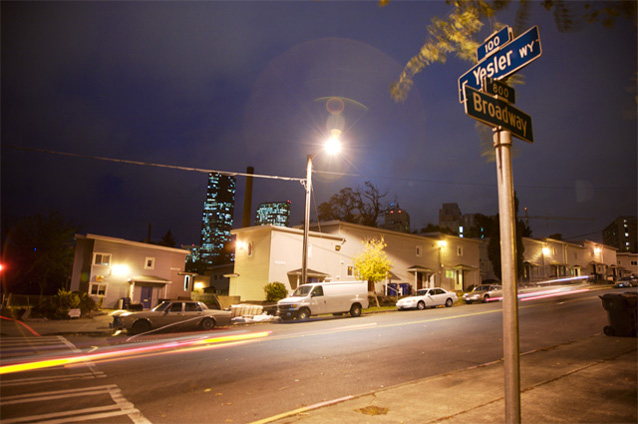Rather than freaking out over poll returns Tuesday evening, I figured I’d go learn something (and then freak out later). So I joined a walking tour of Yesler Terrace, a Seattle public housing project that’s slated for an interesting redevelopment. It’s a useful counter-example to UniverCity, the pretty urbanism-in-suburbia neighborhood outside of Vancouver that’s pretty much unaffordable for anyone who can’t make $1,200 rent.
 Photo: Seattle Housing AuthorityYesler Terrace, by contrast, has rents from around $300, sits in the heart of a city, and hopes to rehab an existing neighborhood — a far more common task than building whole developments from the ground up. It’s a neighborhood of 561 squat, aging duplex-style units built in 1939 as the city’s first public housing project. It’s positioned on a hillside with sweeping views just eight blocks from downtown, adjacent to the city’s First Hill medical hub, and a block or two from the Little Saigon commercial district.
Photo: Seattle Housing AuthorityYesler Terrace, by contrast, has rents from around $300, sits in the heart of a city, and hopes to rehab an existing neighborhood — a far more common task than building whole developments from the ground up. It’s a neighborhood of 561 squat, aging duplex-style units built in 1939 as the city’s first public housing project. It’s positioned on a hillside with sweeping views just eight blocks from downtown, adjacent to the city’s First Hill medical hub, and a block or two from the Little Saigon commercial district.
It also feels like its own insular neighborhood, since few of its internal streets connect to the surrounding grid. It was intended to be a self-contained garden community — a model that was praised at the time. The two-story structures with small yards have provided a landscape more humane than, say, the failed high-rise projects of Chicago. (Electricity for the whole area inexplicably went out while I was there. Kids outside warned each other about walking alone in the dark, but didn’t sound truly scared.)
The design has also left the neighborhood isolated from surrounding areas and their economic offerings. It’s interesting that the upscale UniverCity has the same shortfall. For all its shared yards, walkways, and transit offerings, it still suffers from disconnection from the surrounding grid — in UniverCity’s case, because it’s on a large, forested hill.
 The grid breaks down at Yesler Terrace (center)
The grid breaks down at Yesler Terrace (center)
The Seattle Housing Authority has big plans to replace the Yesler Terrace duplexes with seven-story buildings (in one of several proposals), keeping the same amount of “extremely low-income” homes, adding twice as many somewhat-low-income units, plus several thousand market-rate dwellings, street-level retail, and office space to support the nearby hospitals (more details at Seattlepi.com).
“It can be a place that fits the goals of livability for a lot more people than are currently here,” said Seattle Housing Authority chief Tom Tierney. “We know how to build more healthfully than we did in 1939. We also know we can make a healthier neighborhood with a mix of incomes.”
Building cool places is easier when there’s public money available, and the plan depends on getting a federal Housing and Urban Development grant. Tuesday’s Republican victories suggest voters don’t trust government planning any more than they trust any other centralized authority these days, so funding more of these things isn’t likely to get any easier.
I don’t know the proposal well enough to judge it, but the simple plan to open up streets and walkways to the surrounding neighborhoods should do enormous good. The number of intersections, or “intersection density,” is the single most important factor for keeping people from driving, according to a June study. In a neighborhood where lots of residents struggle to afford cars, that’s essential. (David had a great post a while back about how stitching up the grid of his neighborhood would be terrific for his kids — it’s worth a look for the maps alone.)
On top of that, the planned streetcar line that will run through Yesler between Capitol Hill and the International District will be gravy.
A city planner, when he heard I wrote for a “green” news site, wanted to tell me about the mini-parks and indigenous landscaping in the plans. That sort of greenery is great — essential, in fact. But the main environmental win is simply doing infill that allows more people to use a central, well-connected location.



